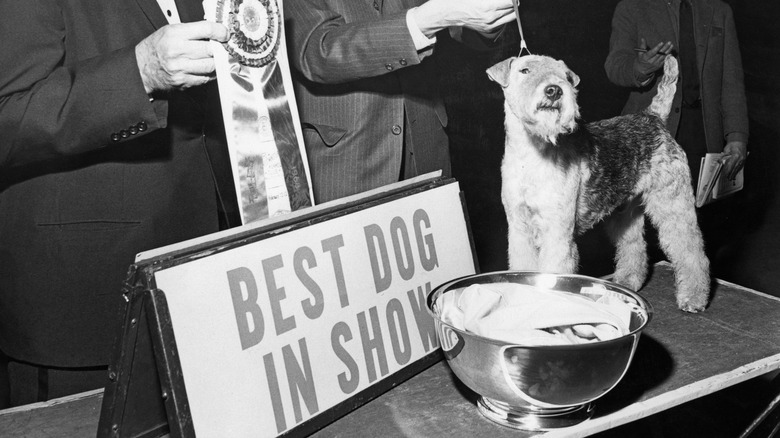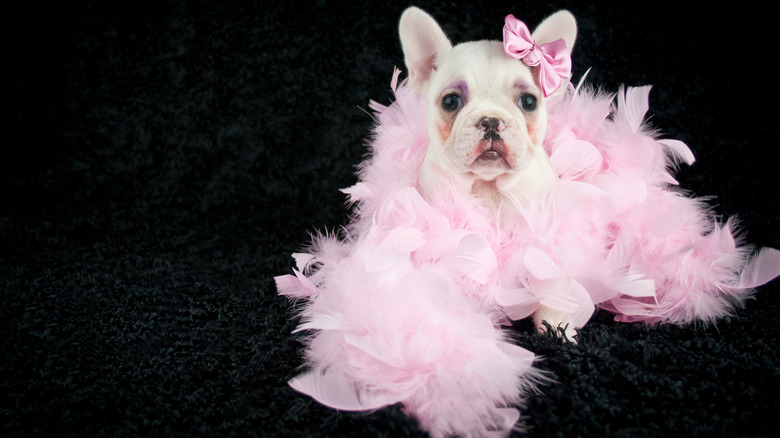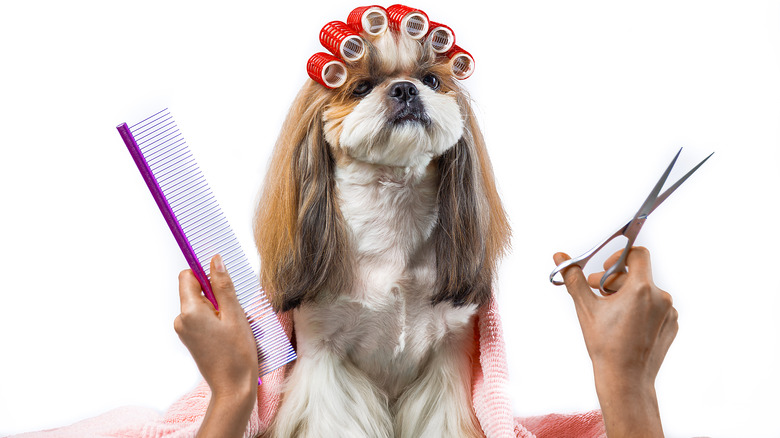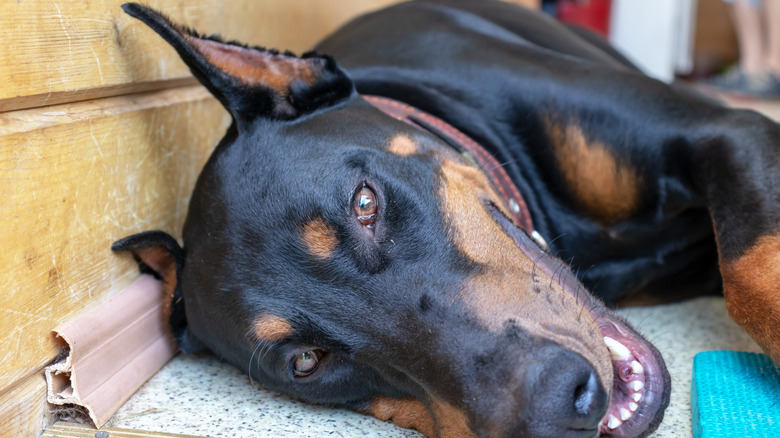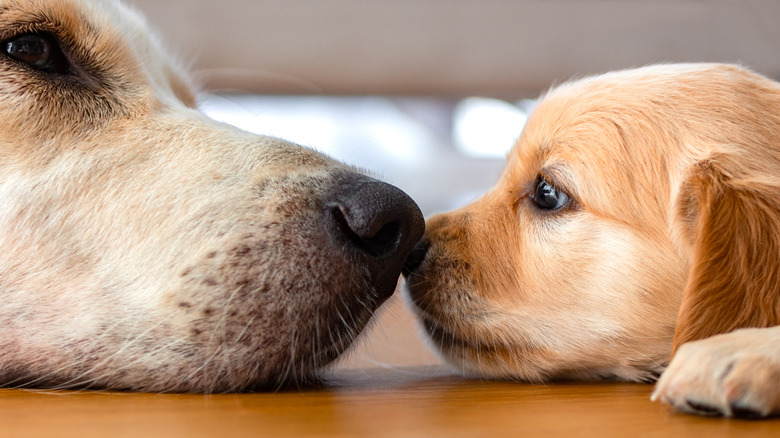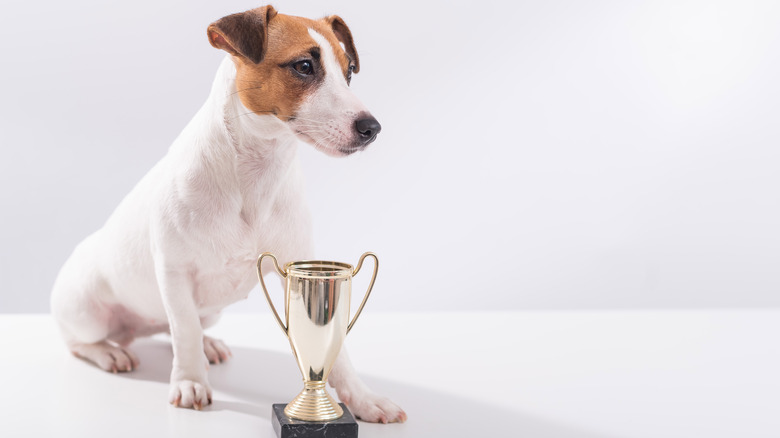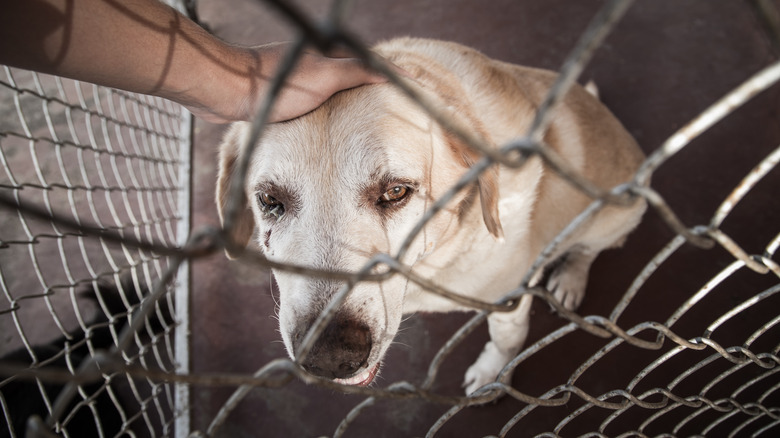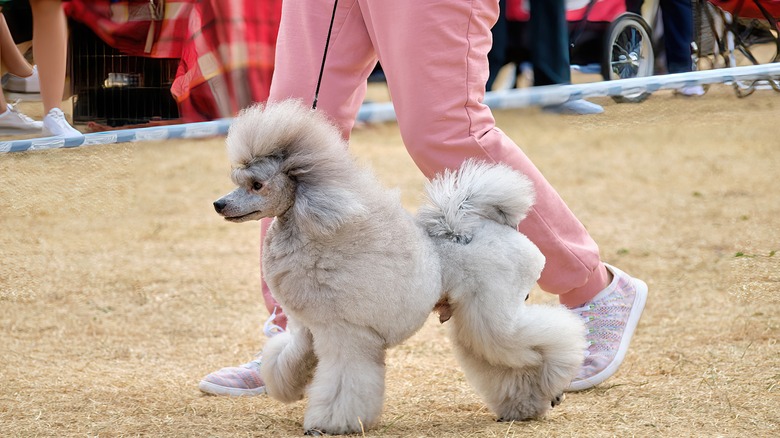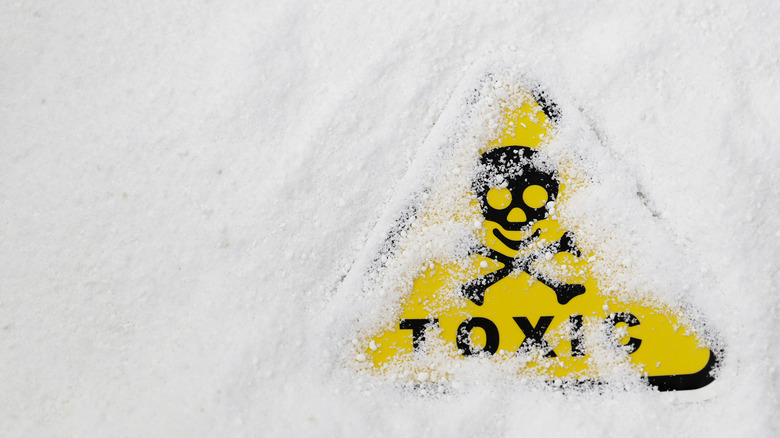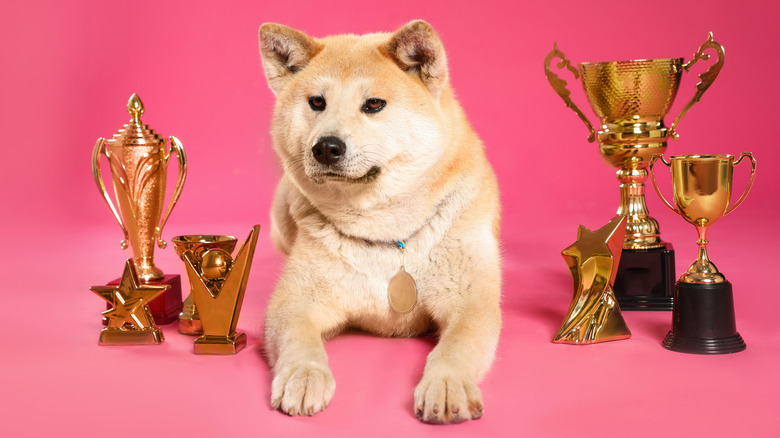Dark Secrets Of Dog Shows Revealed
Behind the parade of perfect paws and glossy coats, there are shady things going on behind the scenes of dog shows. Wondering what it takes to win Best of Breed? Besides flawlessness from nose to tail, it often involves inbreeding. Purebred dogs often suffer from genetic disease they inherit as the offspring of champions in the same bloodline. Sometimes, that prestigious pedigree is so important, a champion stud's sperm is frozen so generations of females can be bred with him. Of course, not every dog ends up with that coveted title. This is why the undesirables are often auctioned off en masse to potential breeders and owners looking for purebreds that might produce a champion.
Dog shows are also rife with sabotage. As Vanity Fair reveals, owners, breeders, and handlers will sometimes do anything to take down other dogs. Sometimes, it even ends in murder, as the horrified owner of a poisoned Irish setter found out when her dog died seizing and vomiting. More poisonings were attempted at the same show, though that dog was the only fatality (via Vanity Fair). Saboteurs have been plaguing dog shows for over a century. They will do anything they can to make a dog unappealing to the judges, from lacing its food with sleeping pills to sneaking it some chocolate, which can leave an unsightly film on the mouth.
This is just some of what canine companions have to face when everyone is vying for that Best in Show ribbon.
Dogs actually have to wear makeup
Some humans can't be bothered to wear makeup, but dogs?
From actual face makeup to chalk for a whiter coat, some people will stop at nothing to get their dog to look absolutely perfect for showtime. That includes cosmetics. This is is a common phenomenon, as one owner told USA Today. She herself refuses to use makeup on her pooch, but confessed to seeing others use eyeliner and even sharpies to enhance the natural dark pigment around the eyes and noses of certain breeds. It's pretty much the canine version of a photo filter. The Sydney Morning Herald reports that owners and handlers who wanted that edge with the judges have been known to break out the eyeliner, lipstick, and hairspray that belonged in their own makeup bags and use it on canine competitors.
It gets worse. Fur dyes that are supposed to bring out that natural colors actually exist. Even worse, the same hair removal creams (think Nair) used by people for flawless skin are also used on mostly hairless breeds that might have a stray strand or two flying around. There are shows that have started turning around. In 2010, the Herald announced that infamous British dog show Crufts finally banned doggie makeup, though it isn't always easy to find evidence of the human products used on dogs. Hair removal creams leave almost nothing behind. After the ban, Crufts officials warned that they would be on the lookout for anything suspicious.
Grooming can get downright painful
Whether it's leading up to the show or the hours before, grooming can be downright painful.
Sometimes the agony a dog faces during grooming depends on the breed. Breeds which have more wiry coats, such as terriers, have to go through the process of "hand stripping" — pulling out a dog's hair for a perfect coat. Dog show supplier Show Dog Store describes this in painstaking detail. Hand stripping supposedly gets rid of worn hairs while enhancing texture. The company claims that these hairs would end up being shed outside anyway, but owners can't exactly wait for that, because timing is everything when it comes to show deadlines. Why not just shave? It sounds more humane, but the company insists that shaving a dog's coat can end up in its texture and even color being ruined. No judge wants to see that.
Dogs who only undergo hand stripping or makeup are more fortunate than those that are abused prior to the show. This doesn't just happen besides the scenes, but also at the grooming salon, as CBS 58 News reports. A Wisconsin show groomer who had been prepping pooches to be show-ready for years was caught after two videos of her beating dogs went viral. While the groomer claimed it was revenge for a customer who was bent on taking down her business, what those videos revealed was animal cruelty. Her grooming parlor was later investigated by the police.
Sometimes, a dog might have to put up with plastic surgery
Is pain really beauty? While some might think so when it comes to putting up with nips and tucks, humans can consent to plastic surgery procedures — but dogs cannot.
There are dog breeds whose natural ears and tails may be considered too long and wild for the show ring, according to The Washington Post, so much so that they have made it impossible for otherwise perfect competitors to come anywhere close to winning. Breeder Leslie Fried is sadly too familiar with this after breeding Rottweilers for decades, many of them picking up ribbons and trophies along the way. Kyra was one of the first whose naturally long and bushy tail she refused to have surgically shortened or "docked." Judges (not to mention other owners and handlers) were appalled. As Fried told the Post, "People were saying 'Get that mongrel out of the ring.'"
After paying countless entry fees to show Tyra only to walk away with nothing, Fried found she had no choice but to dock the tails of Tyra's puppies, one of which did climb the ranks. The RSPCA argues that tail docking is excruciating. While those who insist on docking the tails of future champion puppies argue that their nervous systems are not developed enough to feel anything, they are actually fully developed at birth. Ear cropping has similar repercussions. Also painful, it is done on dogs whose ears are considered too long, but the American Kennel Club (AKC) accepts ear cropping and tail docking as legitimate practices.
Purebreds are overbred again and again
Purebred dogs often win the coveted ribbons, but the sad truth about these dogs is that some of the traits they are bred for actually hinder their health.
While dogs used to be bred for traits such as temperament and hunting ability, breeding has taken a turn towards something more superficial, according to Scientific American. Show dogs are bred mostly for looks. What that means is that many lines often end up so inbred that they end up suffering from various genetic diseases, and if a champion is bred over and over, puppies which inherit that dog's genetic profile also end up suffering. The specific types of physical features that are so desirable in purebreds can also cause them a lifetime of struggles. The problem with the AKC is that it determines these standards, and unethical breeding practices are usually not its concern.
The Cavalier King Charles Spaniel is like the Cadillac of canines, but its defective genes mean it often develops a serious heart condition along with a neurological disease that adversely affects the brain and spinal cord. Flat-faced breeds like bulldogs frequently deal with respiratory problems. Larger breeds that get too large suffer from hip problems; already small breeds bred to be petite often have knees prone to being dislocated. The University of California of Santa Barbara lists these breeds, along with golden retrievers, German shepherds, beagles, poodles, daschunds, Yorkshire terriers, and shih tzuhs as some of the most overbred.
Frozen semen keeps champion bloodlines — and genetic diseases — alive
Breeders know when they have a unicorn. Dogs that keep beating out the competition are bred repeatedly, but they won't live forever. The answer? Freeze their semen.
The AKC allows for litters conceived from frozen sperm to be registered. Cryo-semen can last for years and even decades, as The New York Times reports. Artificial insemination with this sperm has been used to produce champion show dogs since the 1960s. Despite keeping the champion's blood alive, genes frozen in time can also carry the diseases that often plague purebreds. It is true that using semen from a distant ancestor can actually broaden the gene pool and put future puppies at less risk from the suffering associated with particular breeds. But it doesn't eliminate the possibility. If the same semen is used with too many litters that are too closely related to each other, it is no different from breeding the same living dog.
There are actually dog sperm banks that specialize in this kind of thing. However, breed standards can change. Puppies bred from a dog that won best in breed 20 years ago may come out looking more like the champs of that era. There is also no guarantee that semen which was frozen years back will actually impregnate a female, though the oldest sample that ever took was 27 years old, according to the Seattle Times. Breeders tend to just keep sperm samples from champion dogs that have not been bred yet. They want it on hand just in case.
Fancy breeds often come from auctions and puppy mills
It may seem that the impeccably groomed dogs which parade around shows like Crufts and Westminster come only from the most prestigious breeders, but the reality is not always so glamorous.
Often commodified as if they were inanimate objects, dogs are legally considered property, according to Forbes. Dog auctions treat them like products and property more than sentient animals. Selling dogs is an industry worth tens of billions worldwide, and the U.S. shows the highest demand. Auctions can be incredibly lucrative — some rack up hundreds of thousands of dollars in just one day — with individual dogs sometimes fetching five figures. Breeders can be the sellers and buyers. The problem with the sellers is that they are usually huge commercial breeders who give little regard about animal welfare in their serial breeding efforts.
Dogs that are bred for showing but then considered to be subpar are often auctioned off. As Michigan State University found out, the worth of some of these dogs ends up skyrocketing past the price their breeders usually charge, and other breeders who want champion blood will fight over one with a prestigious bloodline. Puppy mills, which breed dogs in deplorable conditions and often literally to death for the sake of supplying pet stores, will also use these auctions to get extras off their hands. Recuse groups that try to bid have no ill intentions, but the unfortunate thing is that all the money they spend goes right back into the cycle of corruption.
Dog shows are big money at the expense of the dogs
Breeders and owners with big money almost always have a leg up at these events. Their dogs have family lines that would put human royalty to shame, according to Salon.
Some dogs have so much prestige that people actually invest in them. Matisse, the Portuguese water dog related to the canine companion of none other than President Barack Obama, was financially backed by a tremendous name in the financial sphere. Matisse's shareholders were more than just disappointed when a beagle outshone this fancier dog to become Westminster champ in 2015. These are elite investors don't stop at just one dog — or one show. But they tend to go silent when asked about the huge amounts of money that are exchanged behind the scenes.
The Seattle Times says that even semen from one of these dogs could start at $2,500. This is what happens when a dog ends up on the podium year after year and other breeders get desperate for some fo those magical genes. As Salon also mentioned, newly crowned champions create more demand for purebreds. With the rising demand that prestigious titles breed, prices keep climbing, and the offspring of winning dogs can be worth thousands of dollars. That doesn't exactly help with the inbreeding issues that purebreds face. Even the AKC admits that showing off these four-legged champs on TV is a business booster.
Humans are guilty of bad behavior, too
It's not only the dogs that might sometimes misbehave. From parking to grooming and everything in between, owners and handlers are usually the ones brandishing their claws at a competition.
Just trying to secure parking can be stressful, according to Showsight Magazine. As if the entry fees are not expensive enough, parking fees and availability (not to mention water, sewer, and electricity charges) often spark drama and fights with parking attendants. It can cost up to $50 per day just to claim a spot. Backstage grooming space also ends up being tight. Some shows rent out space ahead of the event, but others function on a first come, first serve basis, which can be a real problem if it takes so much extra time just to park your car. This means there is no guarantee you'll be able to have enough room to groom your dog. Those who are able to get in early often set up space for themselves and refuse to share, making a scene when confronted by show staff.
Then there are the handlers or owners who go from verbally abusing people to physically abusing dogs. TV Guide Time reported on handler Melanie Rock, a supposedly experienced trainer who acted anything but professional at the 2022 AKC National Team Tryouts. She was caught grabbing a dog by its head and screaming at it, and things escalated when she nearly hung it and choked it with its leash. The AKC stated this was unacceptable.
Too much show stress and exertion can be torture
If the stress humans deal with at dog shows is rough, it can be overkill for the dogs.
Dogs need to at least appear like they can take on anything in the ring. However, even visions of perfection have unexpectedly collapsed afterward. According to SF Gate San Francisco, the Pekingese who won best in show at Crufts in 2003 went through so much physical pressure that he ended up desperately struggling to breathe. Turned out he was suffering from heat exhaustion. The pooped pooch needed to lie on an ice pack to cool down afterwards. Obviously, the barrage of post-win photographs that usually come with being a champ were not an option.
There are many signs of stress that dog owners should not ignore, and the AKC's guide includes panting, growling, pacing, stiffness, avoiding eye contact, and constant yawning, whining, or barking. The AKC also recommends that owners and handlers should be aware of how they are acting, because dogs can be stressed by human behavior that they observe. SF Gate says that showing a dog in the ring shouldn't be much pressure for the dog (though the human handlers may break a sweat). However, if the dog is stressed from something else beforehand, any behavior that betrays that stress could be an instant disqualification.
Some owners will literally kill the competition with poison
When Jagger, an Irish Setter who snagged a second-place ribbon at the prestigious Crufts dog show, died an agonizing death after being fed poisoned treats, it opened up an entire scandal.
Vanity Fair reports this as having been the only successful murder in a series of poisonings that happened at Crufts in 2015. Jagger's last moments were fraught with convulsions, vomiting, and diarrhea until he finally succumbed. An autopsy revealed beef chunks with hidden centers of poison. As headlines splashed across leading British tabloids, evidence of at least five other poisonings at the same show surfaced. Whoever did the poisoning apparently meant to throw the dogs off in the ring so they wouldn't wow the judges. Whether the tainted treats were meant to kill Jagger or just eliminate him from the competition remains unknown, but he was the only dog for which the sabotage attempt was lethal.
This is far from the only time something like this has happened. There is a history of poisoning in dog shows going all the way back to the late 19th century, as a New York Times article from 1895 proves. The owner lost eight dogs to a saboteur who got away with poisoning them, and there was a hefty reward offered for catching the suspect. Vanity Fair notes that not everyone resorts to murder. People will do anything from cutting out chunks of a dog's fur to scratching the pads of its paws so it will not be able to walk flawlessly.
Even winners don't get a break
If a dog manages to make it to the podium, it means prestige for the owner and heightened value for the breeder and anyone (such as handlers and groomers) whose services were involved, but wait. You can't take the leash off just yet.
The "Tailgate" scandal went viral in 2015 after breeder and owner Rebecca Cross lifted up her prize Scottish terrier, who had just won Best in Snow, by the collar and tail to show him off, according to Vanity Fair. Cross had previously been warned about this by show officials. She had agreed to pick the dog up by its stomach and chest as they suggested, but reverted back to the other method after her win. Cross later insisted this was the best way to pick up this breed because of its short, especially tough tail, so she had made it a habit. Officials were aghast. As she told Vanity Fair, "I could hear the stewards near me inhaling, as if to say, 'Oh no! She did it!'"
Other competitors at the show and legions of dog lovers on the internet begged to differ. The "Tailgate" scandal blew up with a petition to take away her title and ban her, which managed to gather over 110,000 signatures. She managed to hold on to the title after she answered a letter from the British Kennel Club with an apology, as the Mirror reports. Overseers of the show finally decided Cross would not face any consequences, but her reputation was tarnished.
